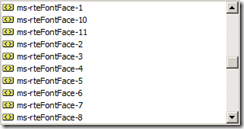I needed to create a sizable test in SharePoint using a custom list. I did not want to manually configure each column so I build a tab delimited text file that held the column configuration options and a PowerShell script to read it. The first column of the file provides the field name, the second provides the options (they were separated by a pipe delimiter), and the third column is the field description. I wanted all of the questions to be Radio Button choice fields so those options were hard coded. I also wanted a letter and appended to each answer so I created an array of letters up to G.
$w = get-spweb http://spsite
$l = $w.lists["MyTest"]$letters = "A|B|C|D|E|F|G"
$lttr = $letters.split("|")
$spFieldType = [Microsoft.SharePoint.SPFieldType]::Choice$file = Get-Content c:\Questions.txt
foreach ($line in $file) {
$fields = $line.ToString().Split("`t")
$fName = $l.Fields.Add($fields[0],$spFieldType,$True)
write-host $fName
$f = $l.Fields[$fName]
$choices = $fields[1].split("|")for ($i=0; $i -lt $choices.count; $i++)
{
$choiceValue = $lttr[$i] + ". " + $choices[$i]
$f.Choices.Add($choiceValue)
}
$f.description = $fields[2]
$f.EditFormat = "RadioButtons"
$f.update()}
The script works like a champ, and I saved myself a little time and frustration of repetitively clicking the same options over and over again.








